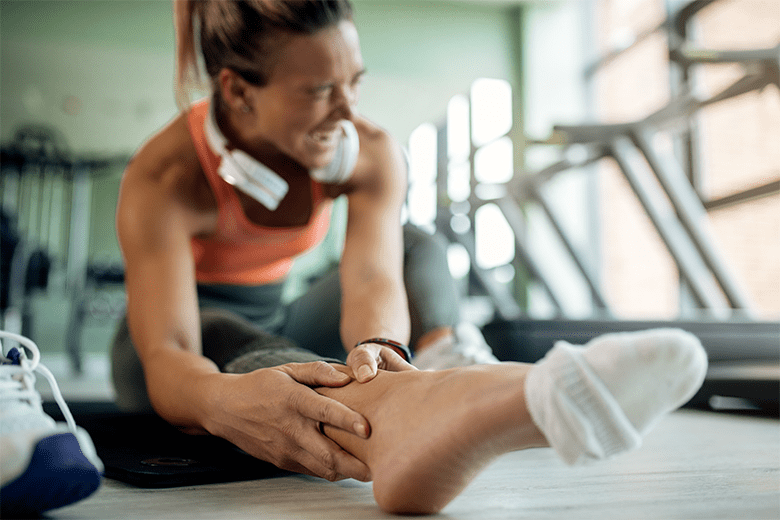Ankle sprain: 5 natural remedies

- 1 Symptoms and causes of a sprained ankle
- 2 After an ankle sprain
- 3 Numerous beneficial properties
Ankle sprain
The ankle sprain is one of the most common problems in sports: in Italy, more than 50 million ankle injuries occur daily, particularly in volleyball, basketball, football, and running.
It is, in fact, one of the most common injuries in sports.
But that’s not all: it can happen during everyday activities, such as walking on uneven ground.
Symptoms and causes of a sprained ankle
An ankle sprain is one of the most common injuries that doctors treat.
Most patients think it might be a pain that goes away with time, but this is not the case: 40 percent of so-called ‘sprains’ lead to chronic problems if neglected.
Particularly in sports, the incidence of this disorder is much higher – up to 21 percent of sportsmen and women – but since it is a minor injury, only a tiny proportion are prone to a subsequent ankle or foot fracture. In any case, it is good to pay attention to the problem and take immediate action when the first symptoms emerge.
In most cases, ankle sprains occur due to sudden movements during a sports performance. The moment you feel a twinge in your ankle when you put your weight on it, consider it an early warning sign of a possible sprain.
A series of more apparent symptoms usually follow, such as swelling, bruising, inability to walk without feeling pain, hypersensitivity, and softness when touching the bruised part.
Unfortunately, the symptoms of a sprain and a fracture are very similar, and the two injuries are often confused.
It is, therefore, essential to consult a doctor as soon as possible who can understand the type of injury through MRI or X-ray examinations to receive the most suitable therapy.
Recovering after an ankle sprain: what to do
After an accurate examination, the doctor decides on the recovery time to treat the ankle sprain: usually two to three weeks of rest, depending on the severity of the injury.
The time may vary depending on the presence or absence of other pathologies and how much strain is put on the ankle.
Initially, you will use crutches to help you walk and later, an ankle brace or orthopedic boot to provide more support.
One of the most frequently used methods to treat ankle sprains is the RICE method, whose acronym stands for:
-R: stands for ‘rest’; in fact, immediately after the sprain, it is good to put the ankle at rest and avoid any strain or pressure on the area
-I: stands for ‘ice,’ i.e., the use of ice in cold therapy, widely used in the case of muscle tears, a meniscus injury, or a medial collateral ligament injury.
Applying a Polaris ice pack to the sprained ankle reduces inflammation caused by increased blood flow and should be done no more than three times a day for no more than twenty consecutive minutes
-C: stands for ‘compression,’ which helps reduce inflammation and swelling.
In this case, it is sufficient to apply a dressing to the affected area, making sure it is not too tight, to allow some mobility to the ankle
-E: stands for ‘elevation.’ It is necessary to hold the distorted ankle in an elevated position, perhaps by placing the foot on a soft surface to encourage blood flow.
Another advanced version of this practice is called POLICE, that includes extra steps.
The initial protection (i.e., the P) is used to secure the ankle before applying ice and compression. OL stands for ‘Optimal Loading’ and indicates the right amount of activity to stimulate healing.
This new methodology is an alternative to the RICE theory of absolute rest. Still, it includes some critical steps such as ice (I), compression (C), and elevation (E).
Another tool to help ankle sprains is ankle taping. Choose an elastic bands with the appropriate level of tension to restore ligament and ankle mobility. Proprioceptive exercises are also highly recommended for the optimal recovery of an ankle sprain.
But it doesn’t end there. There are also many grandmother’s remedies for sprained ankles: ‘home-made’ solutions for pain relief.
Grandma's remedies for a sprained ankle
Many athletes rely on medication to relieve the symptoms of the injury.
Here are 5 effective natural remedies for treating an ankle sprain.
The first natural remedy is, of course, rest. It is essential to allow the ankle to rest to heal quickly.
In this case, it is good to avoid any exertion that could worsen the injury.
Ice is the second natural remedy (previously mentioned within the RICE therapy) to soothe pain and reduce swelling.
The third remedy is arnica, a plant with anti-inflammatory, astringent, and pain-relieving properties, that can be applied as an ointment or cream to treat sprains, sprains, contusions, or strains.
This natural remedy is beneficial both in sports and everyday contexts.
The fourth place for sprain natural remedies is ventilated green clay that contains numerous minerals and active substances essential for recovery. Before application, mix the powder with water until it is fluid enough to be smeared over the affected area.
This mixture must then be left on for at least 4 hours or overnight. Green clay, thus, dramatically reduces inflammation and pain.
Finally, aloe vera and chamomile are two other plants helpful in reducing inflammation and relieving pain. Chamomile has antiphlogistic and calming properties and can be taken in the form of herbal tea or as an essential oil.
Aloe vera also has numerous beneficial properties. It can be applied as a gel or cream to reduce pain due to its analgesic properties.
These natural remedies can help reduce the symptoms of an ankle sprain but are no substitute for treatment by a doctor or physiotherapist in the case of a severe injury.
In addition, it is vital to prevent an ankle sprain by practicing strengthening exercises and wearing appropriate footwear during physical activity.








